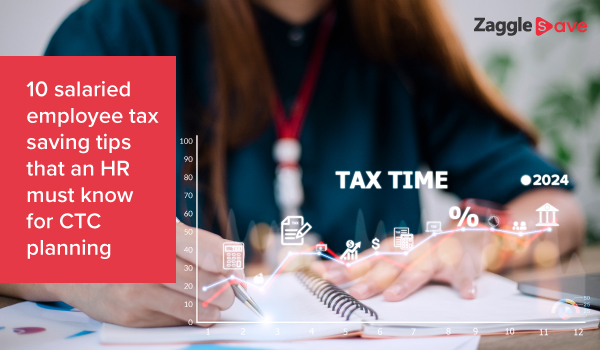Most companies underestimate the role of CTC planning in providing tax savings options for salaried employees. The responsibility is on HR leaders to devise a salary structure that helps individuals leverage maximum tax benefits. It will not only improve your employee experience but also help you establish a standardized compensation process.

If you are an HR looking for ways to learn how best to structure CTC, we discuss the top 10 tips below.
Optimize basic salary to lower tax liability
Tax-saving options for salaried employees begin with the basic salary. It is the amount an individual earns against the working days and forms the primary part of the CTC ranging between 30% – 50%. The basic salary is free from other salary components and deductions. As per the Income Tax Act, basic salary is fully taxable. The more the basic salary, the higher the tax deduction. However, as an HR you can avoid this by providing a lower basic salary and adjusting the amount in other tax saving components like HRA (House Rent Allowance) and Provident Fund (PF).
Strategize utilization of exempted allowances
Section 10 of the Income Tax Act provides tax savings options for salaried employees through a series of allowances. HR leaders can use these tax-exempted allowances strategically to lower tax deductions. Some of these allowances are LTA (Leave Travel Allowance), medical reimbursement, uniform costs, professional development fees, children’s education allowance, etc., Companies can bundle these in their flexible benefits program and give employees flexibility to choose the components.
Save taxes while saving for retirement
As an HR aiming for tax savings for salaried employees, the best approach is to reduce taxable income. You can do this effectively through investment instruments like provident funds (PF) and the National Savings Certificate scheme. Most HRs include gratuity as a part of the salary structure since it is partially tax-exempt. Although this might affect take-home salary, the money saved in taxes is realized as retirement savings.
Make employees part of organization with ESOPs
ESOPs are basically stock option plans that companies grant employees to give them an ownership stake in the business. While enhancing employee experience and making them feel valued, it allows them to reduce their taxable salary. However, you must communicate its details including benefits to the employees thoroughly.
Provide group term life insurance
To ensure tax savings for salaried employees, you can offer group term life insurance coverage for your staff. Although you pay the premiums, they will be tax deductible up to a certain amount. This benefit can be clubbed with a flexi program that you allow employees to select if they want.
Provide meal vouchers as an on-campus benefit
Employees are eligible for meal allowance as per the Income Tax Act, which mandates a certain amount for daily meals as food allowance. HRs can cover this tax-exempted allowance through meal vouchers or food cards
Focus on employee health and well-being
The rules allow partial tax exemption under preventive healthcare expenses, which HRs can leverage to offer better tax savings for salaried employees. It could mean reimbursing gym memberships, yoga subscriptions, or regular health checkups.
Enable employee upskilling while saving tax
Employers can fund skill development courses or certifications for their workforce. Given the ever evolving technological landscape, it is important that employees update their knowledge through relevant courses. HRs can include this as a part of the benefits program, as the fees for such programs can be claimed as a deduction by the company.
Suggest the best tax regime
Since HRs design salary structures, they are ideally placed to educate employees on which tax regime is best suited for maximum tax savings. HRs can evaluate tax saving options for salaried employees between the two regimes, and suggest the best salary structure as per their requirement.
Be up-to-date with changes in tax laws
As an HR leader, it is crucial that you keep yourself informed of all the necessary and relevant changes in tax regulations. If any such change has been introduced, HRs must understand its implications, and propose appropriate measures to ensure tax efficiency of salary structure.
Bonus Tip: Use Zaggle SAVE for easy employee benefits management
Helping individuals leverage tax savings options available for salaried employees can become an operational and administrative overhead. However, you can simplify this using Zaggle SAVE. It is an all-inclusive automation platform that helps HR leaders manage the end-to-end process of implementing a flexible employee benefits program through automated workflows, multi-wallet benefits cards, mobile access, and simplified fund allocation.
Learn more about Zaggle SAVE here.


